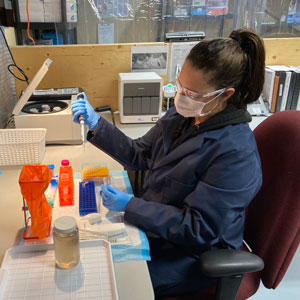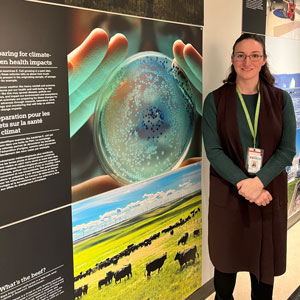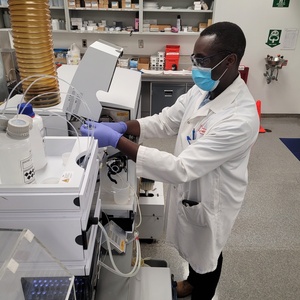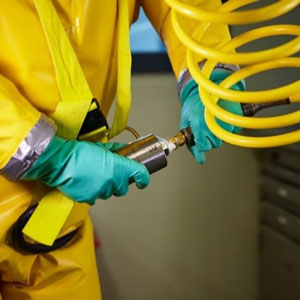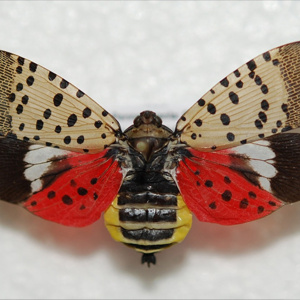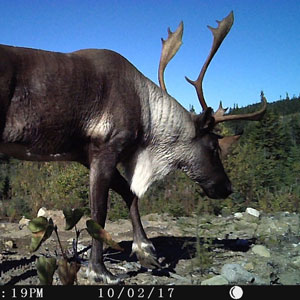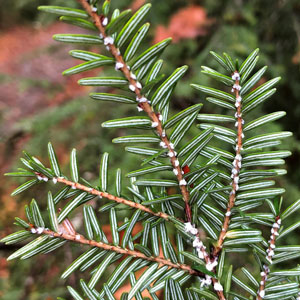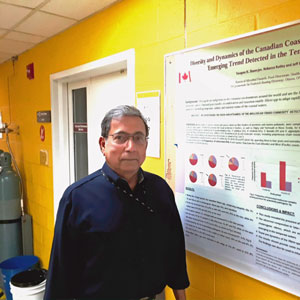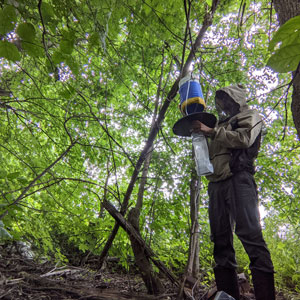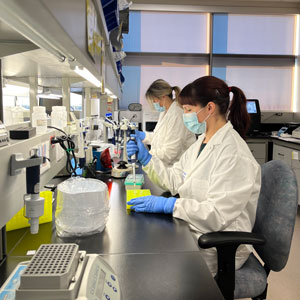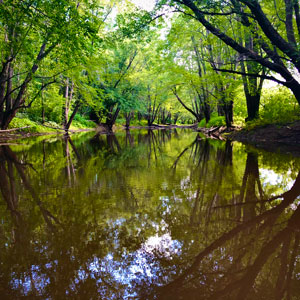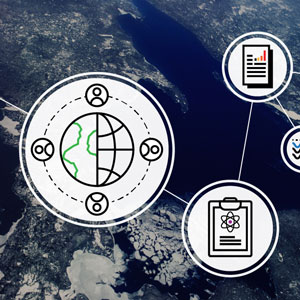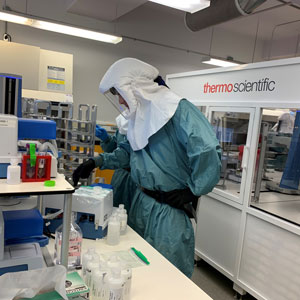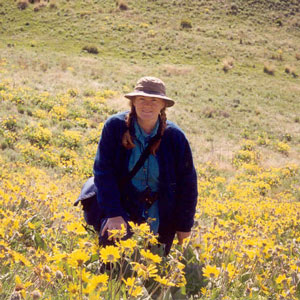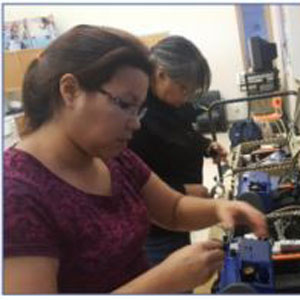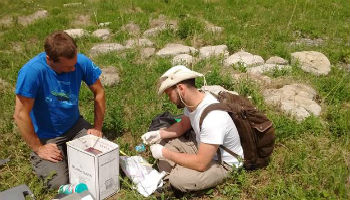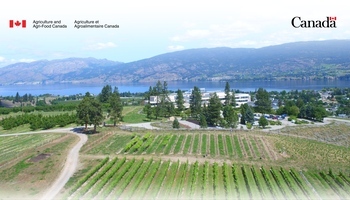Researchers Use Genome Sequencing to Reduce Food Poisoning
December 14, 2022 | from The Science of Health
Study from the National Microbiology Laboratory shows promising results for monkeypox/mpox treatment
December 12, 2022 | from The Science of Health
Community-led wastewater testing in northern, remote and isolated communities
December 1, 2022 | from The Science of Health
NML launches antimicrobial resistance surveillance network
November 21, 2022 | from The Science of Health
Is your home radioactive? Checking up on radon
November 10, 2022 | from The Science of Health
Scientist’s research sheds light on obscure, but highly prevalent foodborne parasite
October 6, 2022 | from The Science of Health
Streamlining food testing at the Dartmouth Laboratory
September 20, 2022 | from Cultivating Science
The Chemistry Section at the Canadian Food Inspection Agency (CFIA) Dartmouth Laboratory in Nova Scotia is responsible for testing fish and other foods for a variety of trace elements and veterinary drug residues. Testing for a long list of compounds involves a variety of methods and instruments, and their effective operation, maintenance and troubleshooting requires specialized skills and expertise.
A First Hand Look Into Being a Field Epidemiologist
September 6, 2022 | from The Science of Health
Hepatitis D research highlights need for increased screening
August 26, 2022 | from The Science of Health
Global experts join together to learn about pandemic preparedness
August 18, 2022 | from Cultivating Science
Ever wonder what it might be like to put on an airtight suit and walk through the interlocking bioseal doors of Canada’s highest containment laboratory in Winnipeg? Behind its doors are some of the deadliest pathogens in the world – we’re talking about Ebola virus, Hendra virus, Nipah virus and more.
Report plant pests to help protect Canada’s plant resources
August 11, 2022 | from Cultivating Science
All Canadians have a role to play in protecting plants in Canada from invasive insects and plant species. This includes reporting findings of plant pests to the Canadian Food Inspection Agency (CFIA). Invasive plants, insects, snails, slugs and pathogens all have the potential to negatively impact Canada’s agriculture, forestry and environmental resources.
The global problem of mercury in the Arctic
August 11, 2022 | from Science Behind the Scenes
Heat at work: an often-underestimated risk
August 11, 2022 | from The Science of Health
NML research finds links between the vaginal microbiome & HIV risk
July 29, 2022 | from The Science of Health
It’s getting hot in here! – Protecting the most vulnerable from indoor heat
July 27, 2022 | from The Science of Health
Getting to the core of apple preference: research peels back the mystery of consumer choice
July 25, 2022 | from The Science of Summerland
Scientists and First Nations together helping caribou reclaim the land
June 28, 2022 | from Science Behind the Scenes
Canada is home to the largest intact forest and wetland ecosystem remaining on planet Earth: the boreal forest. The people of the Essipit Innu First Nation have lived in the southern fringe of that vast forest in the province we now call Québec—part of which the Innu call Nitassinan, or “our land”—since time immemorial.
Surviving the heat: The impacts of the 2021 western heat dome in Canada
June 27, 2022 | from The Science of Health
Residents of British Columbia won’t soon forget the summer of 2021. What we now call the western heat dome was the deadliest weather event in Canada to date. In fact, the BC Coroners Service confirmed that there were 619 heat-related deaths during the heat dome, which took place from June 25 to July 1.
I spy an outbreak: the scientists who track diseases from space
June 27, 2022 | from The Science of Health
What do you see when you look up at the night sky? A few constellations, the North Star, or maybe the moon. We tend to think about space from our perspective on the ground, but what about looking down from space to earth? This is the perspective through which a special team of researchers at the Public Health Agency of Canada (PHAC) study our world, using space technology to track diseases.
Introducing ECCC’s new Director of Indigenous Science
June 9, 2022 | from Science Behind the Scenes
Dr. Myrle Ballard has joined Environment and Climate Change Canada (ECCC) to form the department’s first Indigenous Science division. While on a year-long work exchange from the University of Manitoba, she is leading a permanent team at the department to advance reconciliation in ECCC’s science and research activities. ECCC is the first federal government department to launch such a division, and Dr. Ballard tells us about her exciting and important work.
Joining forces against hemlock woolly adelgid
June 9, 2022 | from Cultivating Science
Many would have been discouraged by the pouring rain and cold winds that settled in southern Ontario on April 21, 2022. But a dedicated team of specialists was undeterred and eager to get to work on some important research on hemlock woolly adelgid (HWA) - an aphid-like insect pest that attacks and kills hemlock trees.
Beneath the sea surface
June 3, 2022 | from The Science of Health
Mosquitoes: a piece of the puzzle for environmental changes affecting human health
June 2, 2022 | from The Science of Health
Harnessing the power of spectroscopy for food safety
April 25, 2022 | from Cultivating Science
Canada’s COVID-19 Variant Hunters
April 21, 2022 | from The Science of Health
Rewilding: helping nature heal itself
March 22, 2022 | from Science Behind the Scenes
Many of Canada’s rivers no longer flow freely due to dams and other barriers restricting the movement of our native species. Watersheds have become degraded by human development to the point where many rivers are cut off from their floodplains, affecting many of the critical services provided by healthy ecosystems.
Scientists use dried blood spot testing to study spread of COVID-19 in Canada
March 14, 2022 | from The Science of Health
Lost in space: Checking up on the health of astronauts
March 7, 2022 | from The Science of Health
From Chemical Reactions to Career Satisfaction with Janice Wong
March 3, 2022 | from The Science of Health
IPCC-55: What it is and why you should care
March 2, 2022 | from Science Behind the Scenes
Detecting diseases earlier: NML collaborates with developing countries to detect emerging pathogens
February 28, 2022 | from The Science of Health
Viral hemorrhagic fevers, such as Ebola, Marburg and Lassa viruses, are an ongoing concern in many West African countries. Scientists at the Public Health Agency of Canada’s National Microbiology Laboratory (NML) are working with some of these nations to build their capacity to detect emerging pathogens through international collaboration.
Mixing it up: Examining new substances in Canada
February 24, 2022 | from The Science of Health
Listen carefully: How research on hearing can change our habits
February 17, 2022 | from The Science of Health
Kids’ Crafting Conundrums: How safe are your art supplies?
February 10, 2022 | from The Science of Health
When COVID-19 surges, federal labs boost Canada’s testing capacity
January 31, 2022 | from The Science of Health
When there is increased demand for COVID-19 testing capacity, driven, for example, by the increase in Omicron cases, a cross-country network of surge capacity testing sites springs into action. Most recently, these sites were used as part of the response to the Omicron wave, which led to a sudden surge in testing needs in Canada.
Was reduced human activity good for birds?
January 27, 2021 | from Science Behind the Scenes
The unprecedented times of the COVID-19 pandemic saw a decline in human activity during various provincial restrictions. Environment and Climate Change Canada (ECCC) researcher, Nancy Mahony collaborated with many partners on a comprehensive study led by the University of Manitoba to ask the question whether or not reduced human activity impacted birds. She talks to us about this collaboration.
Indoor Air Quality and Health: Working with First Nations communities
January 26, 2022 | from The Science of Health
The air quality in our homes is important to our general health. As part of the Government of Canada’s investment in understanding and improving air quality, Health Canada worked with First Nations communities in the Sioux Lookout Zone and other partners to measure indoor air quality, and to examine links with high rates of respiratory infections seen in the region’s First Nations children.
3D models provide insight into the behaviour of COVID-19 variants
January 11, 2022 | from The Science of Health
Hitting the ice: Air quality in arenas
January 10, 2022 | from The Science of Health



